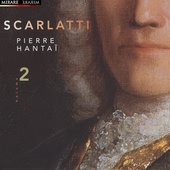Pierre Hantaï’s second Scarlatti collection for Mirare offers interpretations that are thoroughly digested in the harpsichordist’s heart and mind, fastidiously executed, and gorgeously recorded. Although his virtuosity scintillates when necessary, Hantaï generally prefers to probe beneath the music’s attractive keyboard showpiece demeanor, forcing listeners to acknowledge its complex harmonic and rhythmic infrastructures and hotheaded undercurrents. In other words, Hantaï relates to the late Scott Ross in Scarlatti much as Arrau did to Rubinstein in Chopin Nocturnes, or Furtwängler to Toscanini in Beethoven’s Ninth Symphony.
Hantaï doesn’t just arpeggiate left-hand chords with expected stylish flair, but generates palpable tension by way of astute timing and articulation. K135 and K215 are good examples of this. While K25 works well as a jaunty, toccata-like audience pleaser, Hantaï’s more measured fluidity and subtle accentuations uncover an eloquent aria. In less musicianly and experienced hands Hantaï’s deviations from K261’s basic pulse would sound arbitrary or mannered. Here, however, they reinforce the inherent ferocity and sense of surprise in the slashing chords and repeated notes.
How Scarlatti stuffed so many excellent musical ideas within K263’s short space is a question for God, but notice how Hantaï manages to give each one a specific mood and color without creating even a hint of discontinuity, much as film director Robert Altman effortlessly shifts between multiple plot-lines in his epic films. K259 receives a particularly multi-leveled performance, with special attention paid to shaping the four-note phrases of measures 10 and 11 and similar places so that they sing over the bar lines. And in utter contrast to Vladimir Horowitz’s urbane, jewel-like piano interpretation of K260, Hantaï’s broken octaves foam at the mouth and dance in the street. It doesn’t hurt either that Hantaï has a beautiful-sounding instrument at his disposal (an Italian model made by Philippe Humeau à Barbaste in 2002). No Scarlatti lover can afford to miss this enriching release.
































